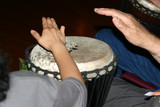You Want Me to What? Drumming Softly and How to Turn Your Drums Down
We don’t really know why, but, there could come a point when you may need to drum without the power of Thor’s hammer. Drumming is all about being loud, strong and full of unstoppable momentum, driving each beat into the ground so that the rhythm is never misunderstood and you became a drummer so that you could pound away without being judged for your need to hit things, right?
Well, not exactly. Drumming is loud, and there is definitely a lot of strength and momentum required to get through a song, much less an entire set of songs. But, what if you’re told that you’re drumming too loudly? How do you keep your beat going when you are forced to temper your rhythm with a more conservative volume? Is drumming softly even possible?
Of course it is, and there are plenty of real-world examples for you to follow. You can look at jazz drummers who use cymbals and brush techniques on their sets for that smooth, laid-back rhythm we all know and love. Kids who are just learning to drum are given tips to keep their sound down, like muffling or using products like Moon Gel (or, practice pads). Drummers in churches often have interesting acoustics to contend with, not to mention a more conservative crowd of people, and they still manage to keep a soft beat going. Drumming softly is possible, and not as hard as you think:
- Check your sticks. Heavier drum sticks will make a louder sound because of the materials, the tips and the velocity needed to strike the drum head. While some drummers may need bigger, stronger sticks to convey their own colossal beat, normally, you won’t find those drummers in a small venue next to a choir. Choose smaller sticks with nylon tips to help decrease your volume.
- How’s your tuning ? Your drum heads can be tuned to quiet your volume – by tightening the top drum head (batter head), you can decrease the volume. But, you may also sacrifice the tone and resonance, or even the snare sound. However, all drums have a little “give and take” when it comes to tuning them, and you can find a compromise between soft volume and the character sound of your drums at full blast.
- What’s in a head ? Your drum head can be made of different types of materials, with various coatings, all of which can increase the volume, overtones and tonal nuances that make your drums a representation of you. If you need to drum softly, consider trying out some different types of drum heads and listen for the difference.
- Hand check ! Your arms, wrists and hands are what make your drums sing, er, beat, at least those drums above your waist. You can’t expect a soft sound if you’re pounding on your drums from the top of your arms’ reach. Settle down a bit and even loosen your grip.
- Speed Demon ? A fast tempo requires a lot of momentum, which will lend to a very loud, pounding rhythm. If you slow it down a bit, your volume can go down, too. But, this is the difference between thrashcore rhythms and what is required by a soft rock ballad… go there if you must.
As a drummer, you must realize that you are, indeed, playing drums and that there aren’t a lot of options that will transform your set into a quiet force of rhythm. The action of drumming is what inevitably makes the volume so loud, and you can’t NOT drum and still allow the rhythm to flow. However, you do have some reasonable options to create a softer drumming sound without giving up on your passion for rhythm, or handing out ear plugs. That’s something.
Recent Posts
-
X8 Drums Play-Along Backing Tracks
The new X8 Play-Along Series is being produced for our musician friends wanting a fresh way to work …9th Feb 2025 -
What is the Best Size Djembe for Beginners?
If you're new to the world of percussion and interested in learning the djembe, you're in for a t …16th Jul 2024 -
The Benefits of Becoming a Drumming Teacher: Transforming Passion into Profession
Why become a drumming teacher? Becoming a drumming teacher is an excellent way to share your pas …22nd May 2024



